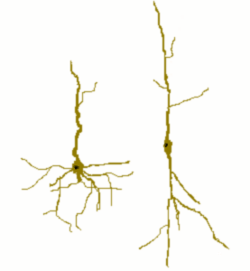| Von Economo neuron | |
|---|---|
 Cartoon of a normal pyramidal cell (left) compared with a von Economo cell (right) | |
| Details | |
| Location | Anterior cingulate cortex (ACC) and Fronto-insular cortex (FI) |
| Shape | Unique spindle-shaped projection neuron |
| Function | Global firing rate regulation and regulation of emotional state |
| Presynaptic connections | Local input to ACC and FI |
| Postsynaptic connections | Frontal and temporal cortex |
| Anatomical terms of neuroanatomy | |

Von Economo neurons, also called spindle neurons, are a specific class of mammalian cortical neurons characterized by a large spindle-shaped soma (or body) gradually tapering into a single apical axon (the ramification that transmits signals) in one direction, with only a single dendrite (the ramification that receives signals) facing opposite. Other cortical neurons tend to have many dendrites, and the bipolar-shaped morphology of von Economo neurons is unique here.
Von Economo neurons are found in two very restricted regions in the brains of hominids (humans and other great apes): the anterior cingulate cortex (ACC) and the fronto-insular cortex (FI) (which each make up the salience network). In 2008, they were also found in the dorsolateral prefrontal cortex of humans.[1] Von Economo neurons are also found in the brains of a number of cetaceans,[2][3][4] African and Asian elephants,[5] and to a lesser extent in macaque monkeys[6] and raccoons.[7] The appearance of von Economo neurons in distantly related clades suggests that they represent convergent evolution – specifically, as an adaptation to accommodate the increasing size of these distantly-related animals' brains.
Von Economo neurons were discovered and first described in 1925 by Austrian psychiatrist and neurologist Constantin von Economo (1876–1931).[8][9]
- ^ Fajardo; Escobar, M.I.; Buriticá, E.; Arteaga, G.; Umbarila, J.; Casanova, M.F.; Pimienta, H.; et al. (4 March 2008). "Von Economo neurons are present in the dorsolateral (dysgranular) prefrontal cortex of humans". Neuroscience Letters. 435 (3): 215–218. doi:10.1016/j.neulet.2008.02.048. PMID 18355958. S2CID 8454354.
- ^ Coghlan, A. (27 November 2006). "Whales boast the brain cells that 'make us human'". New Scientist. Archived from the original on 16 April 2008.
- ^ Hof PR, Van der Gucht E (January 2007). "Structure of the cerebral cortex of the humpback whale, Megaptera novaeangliae (Cetacea, Mysticeti, Balaenopteridae)". Anatomical Record. 290 (1): 1–31. doi:10.1002/ar.20407. PMID 17441195.
- ^ Butti C, Sherwood CC, Hakeem AY, Allman JM, Hof PR (July 2009). "Total number and volume of Von Economo neurons in the cerebral cortex of cetaceans". The Journal of Comparative Neurology. 515 (2): 243–259. doi:10.1002/cne.22055. PMID 19412956. S2CID 6876656.
- ^ Hakeem, A. Y.; Sherwood, C. C.; Bonar, C. J.; Butti, C.; Hof, P. R.; Allman, J. M. (2009). "Von Economo neurons in the elephant brain". The Anatomical Record. 292 (2): 242–248. doi:10.1002/ar.20829. PMID 19089889.
- ^ Evrard HC, Forro T, Logothetis NK (May 2012). "Von Economo neurons in the anterior insula of the macaque monkey". Neuron. 74 (3): 482–489. doi:10.1016/j.neuron.2012.03.003. PMID 22578500.
- ^ Lambert KG, Bardi M, Landis T, Hyer MM, Rzucidlo A, Gehrt S, Anchor C, Jardim Messeder D, Herculano-Houzel S (2014). "Behind the Mask: Neurobiological indicants of emotional resilience and cognitive function in wild raccoons (Procyon lotor)". Society for Neuroscience.
- ^ von Economo, C., & Koskinas, G. N. (1929). The cytoarchitectonics of the human cerebral cortex. London: Oxford University Press
- ^ Triarhou, LC (2006). "The signalling contributions of Constantin von Economo to basic, clinical and evolutionary neuroscience". Brain Research Bulletin. 69 (3): 223–43. doi:10.1016/j.brainresbull.2006.02.001. PMID 16564418. S2CID 21477302.